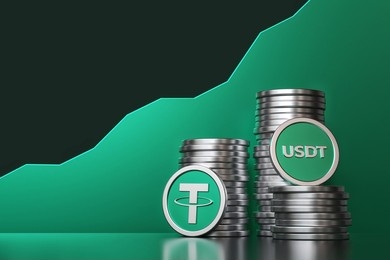Tether Holdings’ USDT stablecoin token has reached a significant milestone by briefly surpassing $100 billion in circulation and market capitalization, making it the first stablecoin to reach this size.
Tether’s USDT aims to maintain a one-to-one value with the US dollar and has experienced a circulation increase of over 9% since the beginning of the year, driven by the growing demand for Bitcoin (BTC), which is currently trading at its highest value in over two years of $66,000.
USDT Market Share Hits 70%, Exceeding $100 Billion In Circulation
CoinGecko data revealed that Tether’s USDT briefly reached $100.2 billion in circulation before settling around $99.5 billion. Tether’s market dominance is notorious, making up approximately 70% of the $142 billion stablecoin sector, while its closest competitor, Circle’s USDC, holds 19.4%.
According to a Bloomberg report, Tether’s stated reserves for USDT reached $97 billion in December, with over 76% of those reserves allocated to short-term US Treasury bills. Rising yields on these assets have significantly boosted Tether’s profitability.
The company also reported excess capital of $2.85 billion in December, which it utilized for investments in industry research, Bitcoin mining, and other areas. Tether’s Chief Executive Paolo Ardoino revealed plans to further expand in these areas in 2024, allocating approximately half a billion dollars solely to fund Bitcoin mining activities.
However, the report also notes that Tether has faced public controversy and regulatory scrutiny due to concerns about transparency regarding its reserves and corporate structure.
In 2021, the company settled allegations by a US watchdog, paying more than $40 million for misleading information about its collateral pile. Tether has since published quarterly attestations of its reserves with a third-party accounting firm, providing limited insights into its holdings.
As Bitcoinist has previously reported, the company has also faced criticism regarding the use of USDT in terrorist financing and human trafficking, particularly in Asian markets.
A January report by the United Nations Office on Drugs and Crime highlighted the involvement of organized crime groups in China using Tether for illegal betting operations. Tether has expressed its commitment to combating the criminal use of cryptocurrencies.
Tether Introduces Blockchain Recovery Plan
According to a recent announcement, the stablecoin issuer is developing a robust blockchain recovery tool to ensure uninterrupted accessibility and security for its users.
The newly introduced blockchain recovery tool reportedly allows the company to maintain its commitment to user security and protect funds, even in “worst-case” scenarios. By operating independently of specific blockchains, Tether can utilize multiple blockchains as a transport layer while ensuring the stability and availability of USDT.
According to the announcement, affected users can initiate the migration process through a user-friendly interface if a supported blockchain becomes unresponsive, unreliable, or unusable. This interface will be accessible via web or command-line tools, providing a seamless experience for Tether users.
To verify ownership of USDT on an unresponsive blockchain, the company has assured that users can cryptographically sign a migration request. Simultaneously, they can specify a recipient address on another supported blockchain to which the USDT will be transferred.
Ultimately, the migration process is designed to be user-centric, supporting popular browser extension wallets and hardware wallets such as Ledger or Trezor.
Featured image from Shutterstock, chart from TradingView.com










